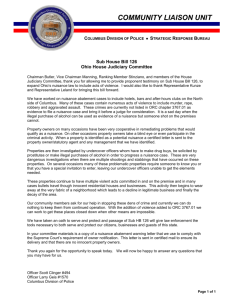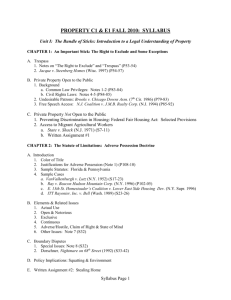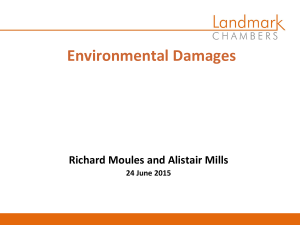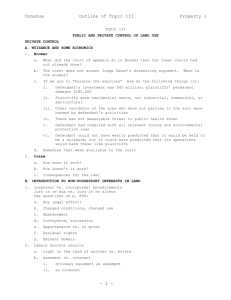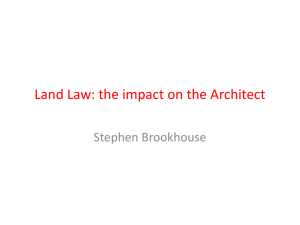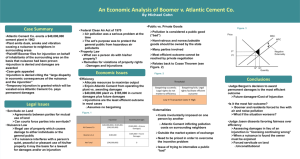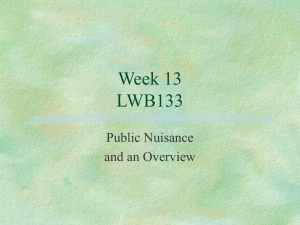Property Checklist
advertisement
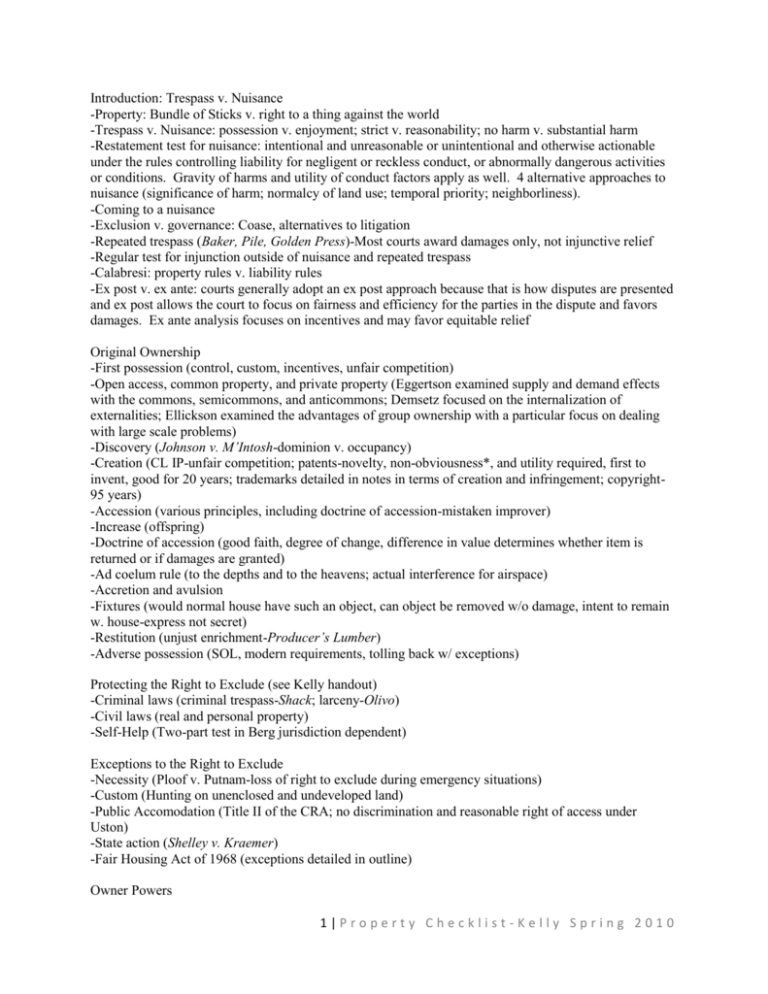
Introduction: Trespass v. Nuisance -Property: Bundle of Sticks v. right to a thing against the world -Trespass v. Nuisance: possession v. enjoyment; strict v. reasonability; no harm v. substantial harm -Restatement test for nuisance: intentional and unreasonable or unintentional and otherwise actionable under the rules controlling liability for negligent or reckless conduct, or abnormally dangerous activities or conditions. Gravity of harms and utility of conduct factors apply as well. 4 alternative approaches to nuisance (significance of harm; normalcy of land use; temporal priority; neighborliness). -Coming to a nuisance -Exclusion v. governance: Coase, alternatives to litigation -Repeated trespass (Baker, Pile, Golden Press)-Most courts award damages only, not injunctive relief -Regular test for injunction outside of nuisance and repeated trespass -Calabresi: property rules v. liability rules -Ex post v. ex ante: courts generally adopt an ex post approach because that is how disputes are presented and ex post allows the court to focus on fairness and efficiency for the parties in the dispute and favors damages. Ex ante analysis focuses on incentives and may favor equitable relief Original Ownership -First possession (control, custom, incentives, unfair competition) -Open access, common property, and private property (Eggertson examined supply and demand effects with the commons, semicommons, and anticommons; Demsetz focused on the internalization of externalities; Ellickson examined the advantages of group ownership with a particular focus on dealing with large scale problems) -Discovery (Johnson v. M’Intosh-dominion v. occupancy) -Creation (CL IP-unfair competition; patents-novelty, non-obviousness*, and utility required, first to invent, good for 20 years; trademarks detailed in notes in terms of creation and infringement; copyright95 years) -Accession (various principles, including doctrine of accession-mistaken improver) -Increase (offspring) -Doctrine of accession (good faith, degree of change, difference in value determines whether item is returned or if damages are granted) -Ad coelum rule (to the depths and to the heavens; actual interference for airspace) -Accretion and avulsion -Fixtures (would normal house have such an object, can object be removed w/o damage, intent to remain w. house-express not secret) -Restitution (unjust enrichment-Producer’s Lumber) -Adverse possession (SOL, modern requirements, tolling back w/ exceptions) Protecting the Right to Exclude (see Kelly handout) -Criminal laws (criminal trespass-Shack; larceny-Olivo) -Civil laws (real and personal property) -Self-Help (Two-part test in Berg jurisdiction dependent) Exceptions to the Right to Exclude -Necessity (Ploof v. Putnam-loss of right to exclude during emergency situations) -Custom (Hunting on unenclosed and undeveloped land) -Public Accomodation (Title II of the CRA; no discrimination and reasonable right of access under Uston) -State action (Shelley v. Kraemer) -Fair Housing Act of 1968 (exceptions detailed in outline) Owner Powers 1|Property Checklist -Kelly Spring 2010 -License (limited permission from owner; terms generally need to be visible (but, ProCD); 3 theories of revocability, standard of care) -Bailments (temp. transfer of custody with expectation of return; standard of care dependent upon beneficiary) -Abandonment and Destruction (can’t abandon perfect title; public welfare limits on destruction) -Transfer of Property (exchange or gift; restraints on alienation; reasonability and restraints) -Nemo Dat (Weimar-BFP; void title v. voidable title; notice) -Recording Acts: Race, Notice, and Race-Notice Notice Statute: A conveyance of an interest in real estate shall not be valid as against any subsequent person who pays substantial value and takes without notice of the prior interest unless the interest in real estate is recorded in the registry of deeds for the county or district in which the land to which it relates lies. Race-Notice Statute: A conveyance of an interest in real estate shall not be valid as against any person who first records his subsequent interest, pays substantial value and takes without notice of the prior interest, unless the interest in real estate is recorded in the registry of deeds for the county or district in which the land to which it relates lies. Estates in Land -Fee Simple (Conservation of Estates: all must boil down to a fee simple) -Life estate (reversion v. remainder) -Defeasible fees -Waste (affirmative, permissive, ameliorative) -Valuation of interest (NPV and expected life) -Restraints on alienation (Mountain Brow) -RAP-contingent remainders, executory interests and vested remainders subject to open -Forms of co-ownership (TIC, JT, TIE-Four unities of JT + marriage for TIE) -Partition (in-kind v. sale; sale generally favored in courts today) -Contribution and accounting (damages and improvements in accounting and ouster) -Harms v. Sprague (mortgage theory-lien v. title-determines severability of JT) Leases -Types (term of years, periodic, at will, at sufferance) -Independent Covenants Model -Dependent Covenants Model (possible cessation of lease if consideration violated) -Constructive eviction (landlord’s intent, action, failure, permissive dissolution of quiet enjoyment) -Surrender (acceptance of surrender through statements or actions inconsistent with the tenant’s rights) Mutual release of contract obligations through implied contract. Rend is owed until acceptance. Landlords use reenter and relet clauses to get around surrender to still hold surrendering tenant responsible for rent until a new occupant is found. -IWH -Mitigation of Damages (not law everywhere, but most places; reasonable efforts) -Transfer of Interests by Landlord (run with the land-touch and concern) -Assignment v. sublease -Assumption and Novation -Condos (foundational rules-arbitrary, contrary to public policy v. promulgated rules-reasonability) -Co-ops (business judgment rule) 2|Property Checklist -Kelly Spring 2010 Incompatible Land Uses -Servitudes (easements v. covenants) -Creation of Easements (grant, implication, necessity, prescription, estoppel) -Types of Easements (appurtenant, in gross, profit, affirmative v. negative (4 in Eng.; not law here), private v. public) -Necessity and implication require common grantor; necessity looks to conditions ant time of creation, implication looks to uses -Types of Covenants (equitable servitude v. real covenant) -Equitable Servitude (injunctive relief; for burden to run-intent, notice, touch and concern; for benefit to run-intent and touch and concern) -Real Covenant (Damages; running burden-intent, horiz. privity, vert. privity, touch and concern; running benefit-intent, vert. privity, and touch and concern) -Conservation easements (really negative covenants in gross) -Zoning (Euclid; cumulative v. non-cumulative schemes; variances v. special exceptions; PUD’s; grandfathering) -Religious institutions (RLUIPA-zoning cannot impose significant burden on religion w/o compelling interest and it being the least restrictive means; definition of significant burden varies widely) Public Rights -Navigation Servitudes (air and water) -Public Trust Doctrine (gov’t can’t dispose of property, exceptions laid out in Illinois Central) -Easement by custom (ex rel Thornton; Blackstone’s six requirements; changeable by legislation) -Water (watercourses, diffuse surface water, underground stream, percolating water) -Reasonable use v. prior appropriation (geographically dependent; appurtenant for reasonable use but separately sellable under prior appropriation; beneficial use for prior appropriation) -Common enemy doctrine for diffuse surface water has yielded to reasonability -Reasonable use and correlative rights for percolating water (withdrawal for overlying lands only) Government Forbearance -Contracts Clause (Charles River Bridge) -DP (5th and 14th; Roth) -Definition of public domain in eminent domain (public use and benefit, economic development, removal of blighted property) -Just compensation for eminent domain (FMV determined by judges, usually at time title is taken, adjusted for DOV or IOV; divided share of fee simple value; based on best use other than intended by taking) -Quick take statutes (allow for rapid title acquisition and judicial review for value) -Regulatory takings: Ad Hoc Rules (Mahon 3 part test; Penn Central 3 part balancing test is now the law) -Categorical Exceptions to Ad Hoc Rules (Permanent Invasion and Destruction of Economic Value) -Permanent Invasion (Loretto; any permanent occupation no matter how small) -Deprivation of Economic Value (Lucas; acceptable actions under the police power only under CL nuisance principles) -State selection between alternative uses (apples v. cedars in Schoene) -Exaction (Nolan-nexus between exaction and purpose; Dollan-rough proportionality) 3|Property Checklist -Kelly Spring 2010


